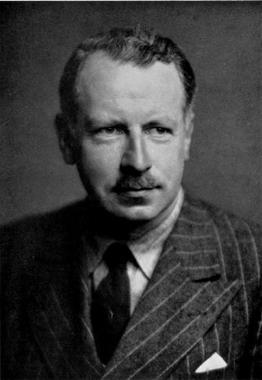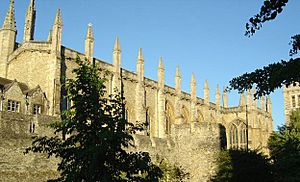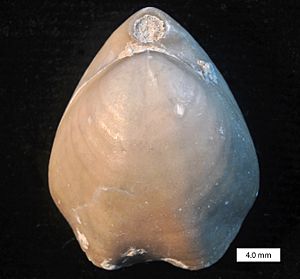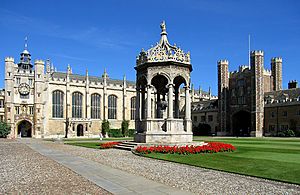William Joscelyn Arkell facts for kids
Quick facts for kids
William Joscelyn Arkell
|
|
|---|---|
 |
|
| Born | 9 June 1904 Highworth, Wiltshire, England
|
| Died | 18 April 1958 (aged 53) Cambridge, United Kingdom
|
| Nationality | British |
| Alma mater | New College, Oxford |
| Known for | Jurassic geology |
| Awards |
|
| Scientific career | |
| Fields | Jurassic palaeontology and stratigraphy |
| Institutions | |
| Doctoral advisor | J.A. Douglas |
| Doctoral students | Anthony Hallam William Stuart McKerrow |
William Joscelyn Arkell was a famous British geologist and palaeontologist. He lived from 1904 to 1958. Many people thought he was the top expert on the Jurassic Period during his time. The Jurassic Period was a time when dinosaurs roamed the Earth, about 201 to 145 million years ago.
Contents
Early Life and Interests
William Arkell was born in Highworth, a town in Wiltshire, England. He was the youngest of seven children. His father, James Arkell, was a partner in a successful family business called Arkell's Brewery. His mother, Laura Jane Arkell, was a talented artist.
From a young age, William loved the English countryside. He spent many summer holidays in Swanage, Dorset, which helped him develop this love. He went to Wellington College for school. There, his teachers noticed his talent for Natural History. He spent a lot of time learning about nature and animals. He often won prizes for his essays on natural history. He even published some poems that showed how much he loved nature and the outdoors.
University Studies
In 1922, William Arkell started studying at New College, Oxford. He first wanted to study entomology, which is the study of insects. But he soon decided that he wanted to focus on geology and palaeontology. Geology is the study of Earth's rocks and history, and palaeontology is the study of fossils.
In 1925, he finished his geology degree with top honors. He stayed at the University of Oxford to do research. His research looked at the different types of bivalves (a type of shellfish) found in Jurassic rocks in England. For this work, he earned his DPhil degree in 1928.
While working on his doctorate, Arkell also spent four winters (from 1926 to 1930) in Egypt. He was looking for signs of early human life in the Nile Valley. He wrote four important books about what he found there.
Important Geological Work
In 1927, Arkell became a geology lecturer at New College, Oxford. By 1929, he was a senior research fellow. This meant he had very few teaching duties, so he could spend almost all his time on research.
In 1933, when he was only 29, he published a huge book called The Jurassic System of Great Britain. This book was 681 pages long! It looked at all the previous work on Jurassic rocks in Britain. This book made him a leading expert on the Jurassic Period.
He also studied the Jurassic limestones found in England, especially the ones used for building in Oxford. He even wrote a book about the different types of limestone used in the city's buildings. Arkell was also interested in how the land in Southern England had changed over time, especially the folded rocks on the Isle of Purbeck.
During World War II, Arkell's research was put on hold. He worked for the Ministry of Transport in London. During this time, he became very ill and spent several months in the hospital.
Work at Cambridge University
After the war, Arkell moved to Trinity College, Cambridge. He became a senior research fellow there and worked at the Sedgwick Museum. At Cambridge, Arkell started to study ammonites. Ammonites are ancient sea creatures with spiral shells, and their fossils are very important for telling the age of rocks. Arkell became the top expert on using ammonites to understand Jurassic rock layers.
Many oil companies sent him fossils to identify. Because of this, he traveled a lot in the Middle East to look at Jurassic rocks there. In 1956, he published another major book, Jurassic Geology of the World. This large, detailed book is still considered a very important book today.
Personal Life and Legacy
William Arkell married Ruby Percival in 1929. They had three sons. They first lived near Oxford and then moved to Cambridge in 1949. They also had a holiday home by the sea in Dorset.
Arkell was a tall man, about 6 feet 4 inches (193 cm) tall. He was not always in good health. In 1956, he had a serious stroke that made it hard for him to move one side of his body and caused him to see double. Even with these challenges, he was determined to keep working and writing at the University of Cambridge. He had another stroke in April 1958 and passed away a few hours later.
Awards and Recognition
William Arkell received many awards for his important work.
- In 1934, he earned a DSc degree from the University of Oxford.
- In 1944, he received the Mary Clark Thompson Medal from the United States National Academy of Sciences.
- In 1947, he was chosen as a Fellow of the Royal Society (FRS), which is a very high honor for scientists in the UK.
- In 1949, he was given the Lyell Medal by the Geological Society of London.
- In 1953, he received the Leopold von Buch medal from the German Geological Society.




